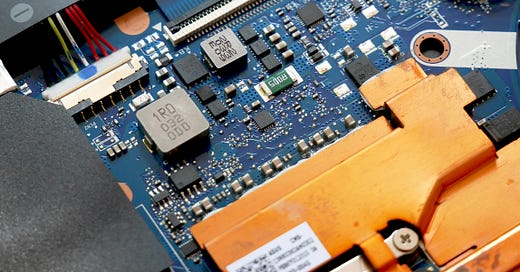Happy Birthday to the CHIPS and Science Act
The uneven impacts of one of the country's landmark industrial policy laws
It’s been two years since President Biden signed the CHIPS and Science Act into law. The bipartisan industrial policy statute aims to bring semiconductor manufacturing back to the US, address supply chain shortages, compete with China, and create good jobs for American workers. Two years in, however, the law seems to be a better deal for the world’s most powerful companies than for working people.
By some metrics, the CHIPS Act is a roaring success. After awarding over $30 billion in grants to 15 companies, the Commerce Department reports the incentives will create more than 115,000 jobs (78,000 construction jobs and 36,000 production jobs) and incentivize over $350 billion in private investment.
But a closer look suggests major challenges with the policy roll-out.
For a start, job creation has not been as advertised. Last week Intel Corporation, the US chip-maker that was awarded the largest CHIPS Act subsidy, announced it was laying off 15 percent of its global workforce. That’s 15,000 jobs lost, far more than the 10,000 permanent jobs the company promised to create in exchange for $19.5 billion from taxpayers.
As the poster child for the CHIPS Act, Intel is a disaster. In the second quarter of 2024, the company reported a net loss of $1.6 billion and declining revenue. Its data center business slumped 3 percent, during the period that the company’s rival Advanced Micro Devices reported a 115 percent increase for its data center business.
Naturally, shares plummeted. Intel is the worst performing tech stock in the Fortune 500 this year.
Intel is not alone when it comes to taking public cash and laying off workers. Two weeks after the government announced a $162 million CHIPS Act award for Microchip Technology, the company announced furloughs for all employees for two weeks in March and another two weeks in June. This turns out to be standard practice in the semiconductor industry: overwork technicians and machine operators to meet production deadlines, then shutter the factory for a few weeks, forcing employees who can’t afford to skip a paycheck or two to use vacation time or go into PTO debt.
Even setting the furloughs aside, many jobs in the chip industry are hardly lucrative. Last month, workers at Analog Devices Inc. in Beaverton, Oregon began to speak publicly about their compensation. It’s a struggle to survive on their wages, they reported, which average about $21 an hour, and they go years without a raise, all while handling toxic chemicals that can cause cancer, miscarriage, and birth defects.
Unfortunately, the CHIPS Act seems to be subsidizing an industry that exacerbates economic inequality. At Micron Corporation, which expects to receive $6.1 billion federal dollars plus $6 billion from New York state, CEO Sanjay Mehrotra earned $25 million last year, 463 times the salary of the median Micron employee, half of whom earn less than $55,000 per year.
At a moment when US workers are increasingly interested in labor unions to raise wages and assert dignity, the semiconductor industry remains staunchly anti-union. Several CHIPS Act recipients have signed agreements with construction unions, hiring union workers to build their new factories. But not one has agreed to remain neutral if permanent production workers decide to organize a union.
So if they’re not hiring workers or raising wages, what are CHIPS Act recipients planning to do with their bundles of cash? A recent study by the Institute for Policy Studies and Americans for Financial Reform Education Fund found that the first eleven CHIPS Act award recipients spent over $41 billion on stock buybacks in the past five years. Stock buybacks artificially inflate the value of corporate shares, enriching executives and shareholders while channeling resources away from payroll, innovation, and productive activity. Although the CHIPS Act explicitly prohibits applicants from using CHIPS funds for this purpose, at least four recipients plan to spend $14 billion on share repurchases in the coming years.
In short, far from creating jobs or spurring innovation, many of our CHIPS Act dollars seem to be going directly into the already fat pockets of corporate execs.
Communities with new CHIPS Act-funded factories have additional concerns about their new neighbors. Chip making requires vast quantities of water: TSMC in drought-stricken Phoenix, Arizona expects to use over 17 million gallons a day in a state that’s been suffering from drought since 1994.
The anticipated energy demand of the four largest CHIPS Act recipients is also massive, more than twice the amount used annually in Seattle, though companies try to conceal this by purchasing bogus “renewable energy certificates” to inflate their green energy claims. The new Micron plant in Boise, Idaho will require more electricity than the entire town of Boise (including industrial customers) uses today.
And chip-making employs thousands of chemicals, many known to be poisonous, with no requirement that companies inform the public about the toxins emitted in their air and water. Santa Clara County, where the semiconductor industry was born in the last century, has more toxic Superfund sites than any other county nationwide, a distinction we should strive not to repeat as we restore chip-making.
By law, the Commerce Department must review the effects of major federal projects on air quality, water, climate change, and environmental justice (among other categories). But so far, the agency seems to be doing a perfunctory job, rubber stamping even the biggest and most disruptive new factories with a Finding Of No Significant Impact or FONSI.
Ayyyy!
These failures are particularly disappointing for those of us who hoped that the CHIPS Act, along with the Inflation Reduction Act and the Bipartisan Infrastructure Law, could represent a meaningful break with neoliberal trickle-down economic policy. President Biden’s three industrial policy bills were supposed to point the way to a new economic paradigm, one that was more equitable, sustainable, and democratic, using the power of the public sector to shape markets for the public good.
Instead, as outgoing Roosevelt Institute President Fellicia Wong has noted, the effort to shift to a new economic paradigm has been most successful “where the policy intervention—public investment—strengthens the power of the more corporate elements of the private sector.” Perhaps nothing exemplifies this observation better than the CHIPS and Science Act, which increasingly resembles old school corporate welfare, with few strings attached.
As the CHIPS Act reaches its terrible twos, then, it’s time to reconsider the path it’s toddling on.
The Commerce Department is still negotiating contracts with award recipients, so it’s not too late to place safeguards on these taxpayer billions to protect workers’ rights and guarantee environmental protections. The coalition I work with, CHIPS Communities United, calls on the Biden-Harris administration to ensure the statute benefits workers and neighboring communities, not just CEOs and shareholders.





Wealth is not all about private equity, even though "corporate managers" and the lawyers they employ might like to think so. Communities also have public assets and the "public trust" is the fundamental background principle of Constitutional Law that has always required us to treat trust assets differently than ordinary property intended for sale. Trust assets must be managed "reasonably" for the benefit of the community (explicitly including future generations). It should be no surprise that some trustees would rather present themselves as "business promoters" and other community members as "tax payers" because the system, as practiced, is far more lucrative for them in their "private" perspective.